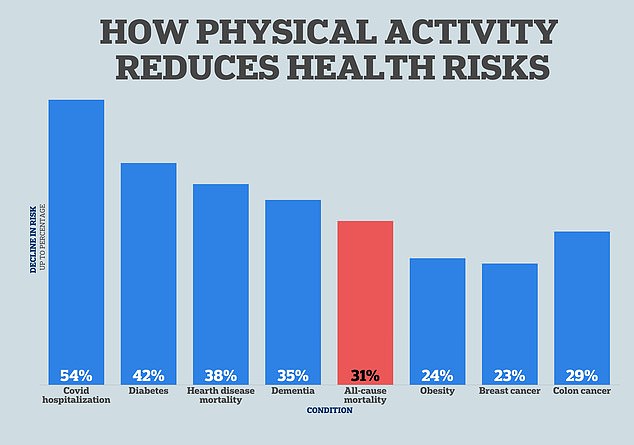Here are the number of sit-ups experts say you should be able to do for your age
Forget extensive and expensive diagnostic tests to determine your health.
According to experts, a simple workout at home could reveal how fit your body is for your age.
Sit-ups are a good measure of muscle strength and endurance, targeting multiple muscle groups, including the abdominals, hip flexors and lower back muscles.
Studies have shown that people who can do more situps are less likely to experience age-related muscle loss, which increases the risk of many other diseases.
Based on age and gender, experts from the fitness website Topend Sports gave an average target number for the number of sit-ups in one minute.
For the 18 to 25 age group, men should set a goal of 35 to 38 and women should work towards the age of 29 to 32 to achieve a good fitness level.
As age increases, the target decreases.
In the 26 to 35 age category, the number for women drops to 25 to 28, while men should be able to perform 31 to 34 sit-ups, according to the online guide.
Experts from fitness website Topend Sports say sit-ups are a good measure of muscle strength and endurance
Fast forward 10 years to 36 to 45, Topend Sports says that women should be able to do 19 to 22 sit-ups, while the figure for men is 27 to 29.
For 46 to 55 year olds, the number drops to 14 to 17 sit-ups for women and 22 to 24 for men.
On the other hand, the average number drops to 17 to 20 for men aged 56 to 65, while for women of the same age, 10 to 12 should be possible, according to the experts.
For the oldest Topend Sports lists (65+), men should be able to do an average of 15 to 18 sit-ups per time, while for women this drops to between 11 and 13.
To perform a correct sit-up, lie on the floor, with your knees bent at a right angle, feet flat and on the floor.
Your hands should rest on your thighs.
Squeeze your stomach and lift your back flat off the ground, high enough so that your hands can slide down your thighs and touch the tops of your knees.
Focus on contracting your core muscles to initiate the movement and don’t use your head or neck as this can lead to injury.
Your lower back should also remain on the floor.
Then lower yourself back to the starting position to complete a full sit-up and continue until you need to stop and rest.

There is now evidence that just 20 minutes of physical activity a day reduces the risk of cancer, dementia and heart disease
Although the guide is touted as an indicator of good fitness levels, fitness experts say it should be taken with a grain of salt.
New York-based personal trainer Caroline Beckwith told DailyMail.com she disagrees with Topend Sports’ suggestions.
She explained, “From what I see with clients, the ‘ideal amount by age’ is usually not what the average person can do.
‘Sit-ups are a great exercise, but they can cause back and neck problems in seniors and are not safe for people with osteoporosis or neck and/or back injuries.
‘When I teach, it is difficult to give feedback for everyone.
‘I usually do ‘dead bugs’ instead of sit-ups or try to hold a plank for as long as possible.
‘Dead Bugs are a core-strengthening exercise where you move opposite arms and legs while lying on your back.
‘I find these are a much safer alternative to sit-ups and don’t put strain on your neck and back.’
To perform dead bug exercises, lie on your back on an exercise mat with your knees bent and feet flat on the floor.
Engage your core and lift your arms straight up toward the ceiling.
Lift your legs until your knees are bent at a 90-degree angle. Inhale and lower one arm toward the floor while extending the other leg toward the floor.
Exhale and return your arm and leg to the starting position. Repeat on the other side.
